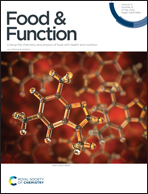Identifying single-strain growth patterns of human gut microbes in response to preterm human milk and formula†
Abstract
The intestinal microbiota of the preterm neonate has become a major research focus, with evidence emerging that the microbiota influences both short and long-term health outcomes, in the neonatal intensive care unit and beyond. Similar to the term microbiome, the preterm gut microbiome is highly influenced by diet, specifically formula and human milk use. This study aims to analyze next-generation products including preterm formula, human milk-oligosaccharide term formula, and preterm breastmilk. We used a culture-based model to differentially compare the growth patterns of individual bacterial strains found in the human intestine. This model probed 24 strains of commensal bacteria and 8 pathobiont species which have previously been found to cause sepsis in preterm neonates. Remarkable differences between strain growth and culture pH were noted after comparing models of formulas and between human milk and formula. Both formula and human milk supported the growth of commensal bacteria; however, the formula products, but not human milk, supported the growth of several specific pathogenic strains. Computational analysis revealed potential connections between long-chain fatty acid and iron uptake from formula in pathobiont organisms. These findings indicate that there is a unique profile of growth in response to human milk and formula and shed light into how the infant gut microbiota could be influenced.



 Please wait while we load your content...
Please wait while we load your content...